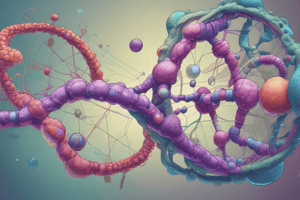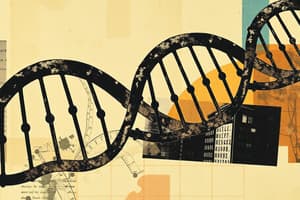Podcast
Questions and Answers
What occurs during the termination phase of DNA replication?
What occurs during the termination phase of DNA replication?
- Telomerase extends the leading strand
- Leading strands synthesize in Okazaki fragments
- Replication forks separate from each other
- The entire DNA molecule has been copied (correct)
What is the main role of telomerase in eukaryotic DNA replication?
What is the main role of telomerase in eukaryotic DNA replication?
- Synthesize Okazaki fragments
- Initiate the replication fork
- Extend telomeres at the ends of linear DNA (correct)
- Proofread errors in DNA sequence
Which strand is synthesized continuously during DNA replication?
Which strand is synthesized continuously during DNA replication?
- Lagging strand only
- Neither leading nor lagging strands
- Both leading and lagging strands
- Leading strand only (correct)
How does DNA polymerase contribute to the integrity of the DNA sequence?
How does DNA polymerase contribute to the integrity of the DNA sequence?
What is a characteristic of the lagging strand during DNA replication?
What is a characteristic of the lagging strand during DNA replication?
What initiates the unwinding of double-stranded DNA during replication?
What initiates the unwinding of double-stranded DNA during replication?
How does DNA polymerase add nucleotides to the leading strand?
How does DNA polymerase add nucleotides to the leading strand?
What distinguishes the synthesis of the leading strand from that of the lagging strand?
What distinguishes the synthesis of the leading strand from that of the lagging strand?
What is the role of DNA ligase in DNA replication?
What is the role of DNA ligase in DNA replication?
Why does primase lay down multiple primers on the lagging strand?
Why does primase lay down multiple primers on the lagging strand?
What stabilizes unwound single-stranded DNA during replication?
What stabilizes unwound single-stranded DNA during replication?
In what direction does DNA polymerase synthesize new DNA?
In what direction does DNA polymerase synthesize new DNA?
What happens to the RNA primers after they are no longer needed on the lagging strand?
What happens to the RNA primers after they are no longer needed on the lagging strand?
Flashcards
Origin of Replication
Origin of Replication
Specific DNA sequences where DNA replication begins.
Helicase
Helicase
Enzyme that unwinds double-stranded DNA by breaking hydrogen bonds between base pairs.
Single-Strand Binding Proteins (SSBs)
Single-Strand Binding Proteins (SSBs)
Proteins that bind to single-stranded DNA during replication, preventing them from re-pairing.
Primase
Primase
Signup and view all the flashcards
Leading Strand
Leading Strand
Signup and view all the flashcards
Lagging Strand
Lagging Strand
Signup and view all the flashcards
Okazaki Fragments
Okazaki Fragments
Signup and view all the flashcards
DNA Ligase
DNA Ligase
Signup and view all the flashcards
Replication Termination
Replication Termination
Signup and view all the flashcards
Telomeres
Telomeres
Signup and view all the flashcards
Telomerase
Telomerase
Signup and view all the flashcards
Study Notes
DNA Replication: Initiation, Elongation, and Termination
- Initiation: The beginning of DNA replication.
- Replication begins at origins of replication, multiple sites to speed replication in eukaryotes.
- Helicase unwinds the DNA double helix, creating the replication fork, by breaking hydrogen bonds between base pairs.
- Single-strand binding proteins (SSBs) stabilize the unwound single strands to prevent them from reannealing.
- Primase synthesizes short RNA primers to provide starting points for DNA polymerase to extend new DNA.
- One primer is needed on the leading strand, and multiple primers are needed on the lagging strand.
Elongation
- Leading Strand: Continuous synthesis in the 5' to 3' direction, matching the movement of the replication fork. DNA polymerase continuously adds nucleotides in one direction.
- Lagging Strand: Discontinuous synthesis in short fragments called Okazaki fragments. Synthesized away from the replication fork. DNA polymerase adds nucleotides in the 5' to 3' direction from each primer.
- DNA Ligase joins the Okazaki fragments together into a continuous strand.
- DNA pol moves in the 5' ----> 3' direction.
Termination
- Replication ends when replication forks meet or when the entire DNA molecule is copied.
- Telomeres (found only in eukaryotic linear DNA): Specialised structures at the ends of chromosomes that require specialized enzymes (telomerase) for complete replication.
- Proofreading and repair enzymes check for and correct errors for higher accuracy.
Leading vs Lagging Strands Summary
| Feature | Leading Strand | Lagging Strand |
|---|---|---|
| Synthesis | Continuous | Discontinuous (Okazaki fragments) |
| Primer Needs | One | Multiple |
| Direction | 5' to 3', same as replication fork | 5' to 3', opposite to replication fork |
| Enzyme Completion | Continuous strand | Joined fragments by DNA ligase |
Studying That Suits You
Use AI to generate personalized quizzes and flashcards to suit your learning preferences.
Description
This quiz covers the key processes of DNA replication including initiation, elongation, and termination. Understand the roles of helicase, DNA polymerase, and the differences between leading and lagging strands. Test your knowledge on how these mechanisms work together to ensure accurate DNA duplication.




